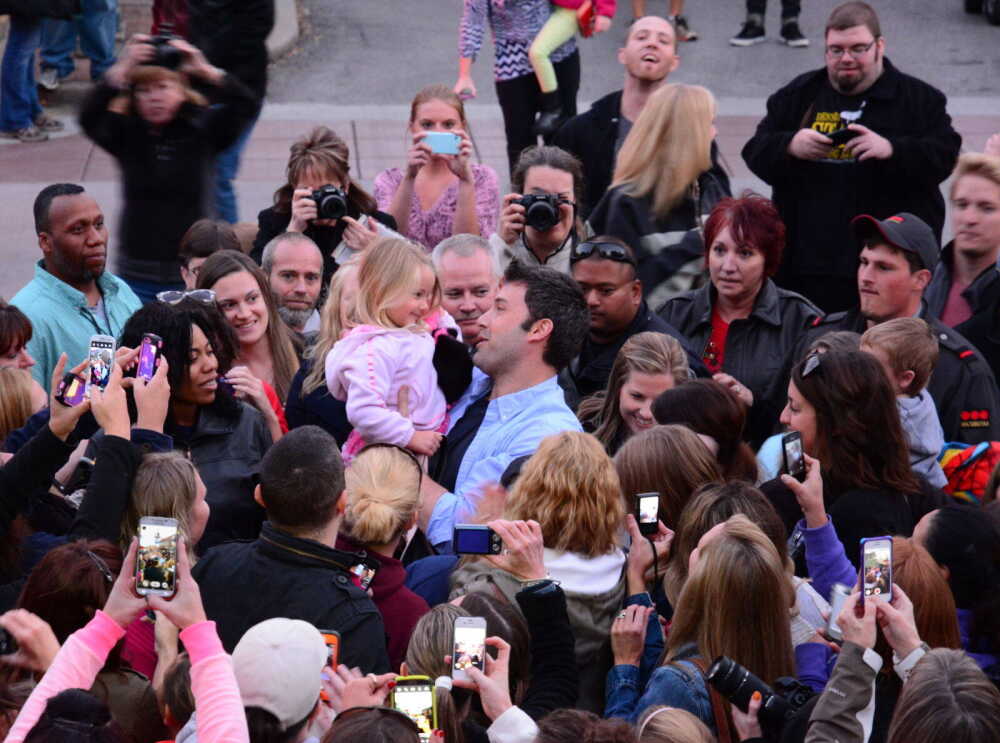Guest column: Revival of film tax incentive on 'Gone Girl' 10-year anniversary

Ten years Gone.
It’s now been a decade since Southeast Missouri saw the beginning of production for the film “Gone Girl”.
Directed by David Fincher, and starring Ben Affleck, Neil Patrick Harris, Rosemond Pike, Carrie Coon and Tyler Perry, the major film was based on the best-selling novel by Kansas City native Gillian Flynn, who also wrote the screenplay. Cape Girardeau acted as a stand-in for the story’s fictional town of North Carthage, Missouri.
At the time, the state of Missouri had a tax incentive policy that encouraged filmmakers to produce movies in the state and offered a “rebate” on their expenditures. The incentive ended in 2013, and “Gone Girl” was the last film to receive any of the incentive monies. “Gone Girl” was also the last major film to be produced in the state.
In July 2023, Gov. Mike Parson signed a bill that would reintroduce the Show MO Act tax incentive plan to encourage film, television, music and advertising companies to produce their creative content in the state of Missouri again.
The Show MO Act incentivizes filmmakers to produce content in Missouri that would otherwise be produced in other states. The bill is sponsored by Sen. Denny Hoskins and offers an $8 million annual cap for film and $8 million annual cap for episodic television. It provides a base 20% tax credit incentive with the possibility of additional 5% incentive bumps for other specific criteria.
Here’s how it works:
20% tax credit for all qualifying film productions
Extra 5% if at least 15% of the production is filmed in a rural or blighted area
Extra 5% if a certain number of Missouri residents are hired on these productions
Extra 5% if the productions depict the state or region in a positive light
The Department of Economic Development decides which productions are approved. Production companies must first submit an application to state officials to show they have the proper financing for production. After the production has been vetted and approved, the production can begin shooting in Missouri. At the conclusion, an independent audit from a Missouri-licensed CPA confirms the financial output, and then a secondary audit from state officials approves the findings before a rebate is processed.
According to mo.gov, SB94 stablishes tax credits for the production of certain entertainment.

When Gone Girl came to town
For nearly two months in the fall of 2013, a creative and talented film production crew from Hollywood transformed Cape Girardeau, and some surrounding locations, into the fictional setting for “Gone Girl”. The process started months before filming began.
In early 2013, crewmembers began scouting for locations. They needed buildings to serve the plot, production hubs for creating sets, spaces for design, wardrobe, lighting, make-up and more.
Initial production called for a 10-day shoot in Cape Girardeau; they stayed for almost two months.
A Casting Call
At the time, I was a professor of mass media at Southeast Missouri State University (SEMO), and a founding member of the Missouri Motion Media Board of Directors (a not-for-profit board of media professionals that supported the Film Commission for the State of Missouri). I received a call asking for assistance with scouting and casting for extras for a “major motion picture” yet to be named.
The rumors had been swirling for weeks, but no one had a definitive claim to what was coming to Cape. I was contacted by a casting company to help organize a location, date and time to interview potential background extras for the movie. I had a ready-made staff of Film/TV students willing to help with the process and a location that would serve the casting company to interview the extras. With the help of my colleague, Fred Jones, we assembled a crew of students to facilitate the casting call.
I warned the casting people that once word got out about “a movie” needing background cast members and extras, a mass of people would show up for auditions. They had worked on other film productions and were not concerned about being overwhelmed.
I created a news release that was sent to multiple media outlets around the four states bordering the Cape Girardeau area. The date, time and location were set for a “Casting Call for Extras” for a major motion picture to be filmed in Cape Girardeau. Within seconds, and I mean seconds, after the news release dropped to the media, I got calls from all over the Midwest.
Rose Theatre on SEMO’s campus served as the location for auditions, and when we opened at 8 a.m., hundreds of people were already lined up waiting to get in.
Rose Theatre has 496 seats; we filled that auditorium several times that day with prospective actors. The casting crew thought we would only see a few hundred. We saw thousands that day. And we did this three times over a few weeks, twice for the public and once for SEMO theatre students.
We had people travel from Ohio, Indiana, Oklahoma, Arkansas, Tennessee, Iowa, Kentucky, Mississippi, Illinois and all over Missouri — just to get a shot at being a background extra.
Finding the Right Place
As casting for background actors was in process, other production personnel were scouting various locations for the film’s storyline. For six weeks in September and October, more than 30 locations in and around Cape Girardeau were used.
Everyone from this area recognizes the many locations and some of the private homes used: “The Bar,” at North Main and Themis, the Common Pleas Courthouse, the Federal Building on Broadway, Cape Woods Conservation Area, along with a few private homes. Craft services, the private vendors hired to feed cast and crew, were located at what is now the Rust Center for Media, which functions as the TV studio for SEMO’s Mass Media Department.
If you lived in this area 10 years ago, more than likely you either have a “Gone Girl” story or have heard from someone else about their “Gone Girl” story. This could be a small part in the movie, an Affleck interaction, Fincher or Flynn autograph and greeting, dinner or drinks with the crew, among others.

I was fortunate to have met several of the production personnel for the film. I talked and worked with the creative people that did set design, lighting, cinematography and location scouting, along with production assistants and producers.
Connecting Local Students
One chaotic scene in the movie shows a throng of people and paparazzi descending on Affleck’s character after he leaves the make-shift jail. All the video equipment in that scene was from SEMO’s Mass Media Department.
I worked with the producer and props coordinators to get the cameras, tripods, microphones and lighting equipment to complete the scene. The payment for use of the equipment was not monetary, but instead an opportunity for SEMO students and a few community members to meet with David Fincher for a question-and-answer gathering one evening.
It was a great event and one that stood out to some of the state film personnel who said, “no other school in the state has had an A-list movie director as a guest speaker for a Q&A!”
A Lasting Impact
The impact from “Gone Girl” was more than rubbing elbows with movie stars, producers and a big-time director. The real impact was financial. With more than $8 million spent directly in the Cape area during those few weeks, and the lasting impact on tourism over several years, the financial impact cannot be denied.
The last year the State of Missouri offered a tax incentive to encourage film production in the state was 2013 — the year “Gone Girl” was produced. It has taken 10 years of constant battles with state lawmakers to realize the impact that the film industry, episodic television, music and even advertising and marketing production can have on state tourism.
In July 2023, new legislation was passed to resurrect an incentive for filmmakers to once again produce media content in the state.
Missed Opportunities
After “Gone Girl” was released in 2014, I received many calls about shooting films in Cape Girardeau. Mostly, they were independent films, but two had budgets of $4 and $5 million.
They desired to produce their films in Cape, however, since the tax incentive for the state had lapsed, they didn’t. Those two production teams eventually went to Georgia due to the state’s tax incentive program. Lately, a lot of films or television series have opted to film in Georgia, or other tax incentivized states, that welcome these productions.
The award-winning Netflix series, Ozark, starring Jason Bateman and Laura Linney was set in the Lake of the Ozarks. Producers intended to shoot the series in southwest Missouri, but with no tax incentive, the series moved to Georgia to shoot in 2016.
Tulsa King, the hit series from Paramount+ starring Sylvester Stallone, was originally called Kansas City. The plan was to shoot the series in Missouri and Kansas. However, the show creators decided to rename the series and move production to Oklahoma, since Missouri did not offer incentives for film production.
A Return on Investment
There are several states that incentivize media content producers with a “tax rebate” to shoot in their state. Data shows this money spent pays back with team members relocating to the state and creative teams spending money for sets, props, wardrobe, food, hotel rental, car rentals and other expenses within the state.
In addition to financial gain, there are tourists that may feel compelled to visit a location and see recognizable landmarks from their favorite films. Many communities embrace a film’s legacy and promote it for as long as possible.
I recently returned from a trip to Martha’s Vineyard, a very small and touristy part of Massachusetts, and every store was selling Jaws merchandise: hats, T-shirts, mugs and anything else that could be stamped with a shark. That movie was produced almost 50 years ago, and it is still part of the culture there, making money for many vendors.
A Look to the Future
“Gone Girl” is 10 years old, but it continues to have an impact on our area. Tourists still want to visit the recognizable locations that were part of the film. I’m confident the resurrected tax incentive will bring quality Film and TV production back to our state, creating more hotspots for future tourists to visit and spend time and money in Missouri.
Dr. Jim Dufek is a retired TV/Film professor who spent 39 years at Southeast Missouri State University. He was a founding member of the university’s Department of Mass Media.






























Respond to this story
Posting a comment requires a subscription.